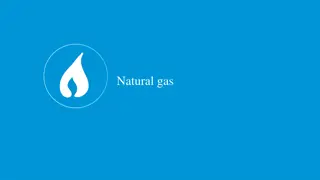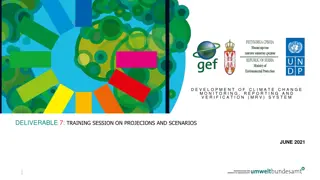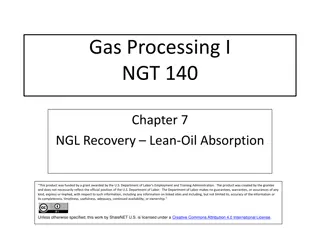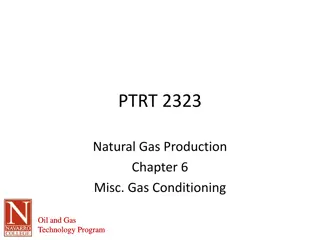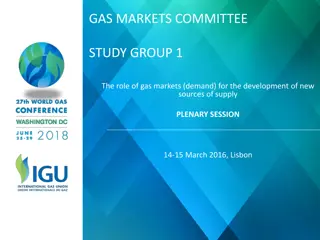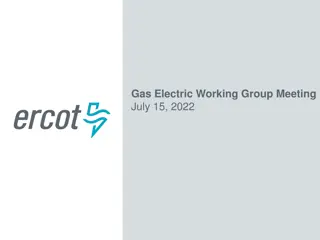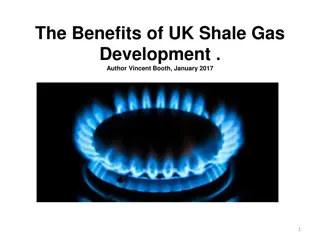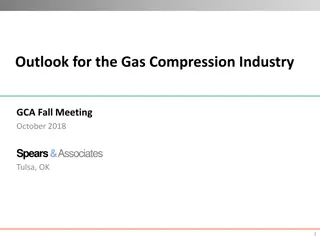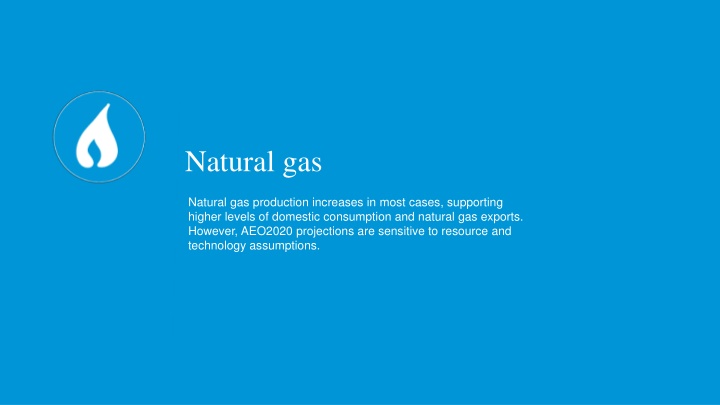
Overview of AEO2020 Natural Gas Projections
Natural gas production influences domestic consumption and exports, with AEO2020 projections sensitive to resource and technology assumptions. The growth of U.S. dry natural gas production outpaces consumption in most cases, impacting prices and exports. Learn about the trends and factors affecting the natural gas industry based on the AEO2020 report.
Download Presentation

Please find below an Image/Link to download the presentation.
The content on the website is provided AS IS for your information and personal use only. It may not be sold, licensed, or shared on other websites without obtaining consent from the author. If you encounter any issues during the download, it is possible that the publisher has removed the file from their server.
You are allowed to download the files provided on this website for personal or commercial use, subject to the condition that they are used lawfully. All files are the property of their respective owners.
The content on the website is provided AS IS for your information and personal use only. It may not be sold, licensed, or shared on other websites without obtaining consent from the author.
E N D
Presentation Transcript
Natural gas Natural gas production increases in most cases, supporting higher levels of domestic consumption and natural gas exports. However, AEO2020 projections are sensitive to resource and technology assumptions. U.S. Energy Information Administration U.S. Energy Information Administration #AEO2020 www.eia.gov/aeo
U.S. Energy Information Administration U.S. Energy Information Administration #AEO2020 www.eia.gov/aeo
U.S. dry natural gas production and consumption increase in most AEO2020 cases AEO2020 U.S. dry natural gas production trillion cubic feet AEO2020 U.S. natural gas consumption trillion cubic feet 2019 2019 50 60 history projections history projections High Oil and Gas Supply High Oil Price High Economic Growth High Renewables Cost Reference Low Renewables Cost Low Economic Growth Low Oil Price Low Oil and Gas Supply 45 50 40 35 40 30 25 30 20 20 15 10 10 5 0 0 2000 2010 2020 2030 2040 2050 2000 2010 2020 2030 2040 2050 U.S. Energy Information Administration U.S. Energy Information Administration 3 #AEO2020 www.eia.gov/aeo
and natural gas production growth outpaces consumption in most cases Natural gas dry production in the AEO2020 Reference case grows 1.9% per year from 2020 to 2025, which is considerably slower than the 5.1%-per-year average growth rate from 2015 to 2020. U.S. natural gas consumption in the Reference case slows after 2020 and remains relatively flat through 2030 because of slower industrial sector growth. Consumption also declines in the electric power sector during this period. After 2030, consumption growth rises almost 1% per year on average as natural gas use in the electric power and industrial sectors increases. U.S. natural gas production grows at a faster rate than consumption in most cases after 2020, leading to an increase in U.S. exports of natural gas. The exception is in the AEO2020 Low Oil and Gas Supply case, where production and consumption remain relatively flat as a result of higher production costs. U.S. Energy Information Administration U.S. Energy Information Administration 4 #AEO2020 www.eia.gov/aeo
AEO2020 natural gas prices depend on resource and technology assumptions AEO2020 dry natural gas production trillion cubic feet AEO2020 natural gas spot price at Henry Hub 2 2019 dollars per million British thermal units 2019 2019 High Oil and Gas Supply 60 12 history projections history projections 50 10 Reference 40 8 Low Oil and Gas Supply 30 6 Low Oil and Gas Supply Reference 4 20 High Oil and Gas Supply 2 10 High Oil and Gas Supply 0 0 2000 2010 2020 2030 2040 2050 2000 2010 2020 2030 2040 2050 U.S. Energy Information Administration U.S. Energy Information Administration 5 #AEO2020 www.eia.gov/aeo
and Henry Hub prices in the AEO2020 Reference case remain lower than $4 per million British thermal units throughout the projection period In the AEO2020 Reference case, growing demand in domestic and export markets leads to increasing natural gas spot prices at the U.S. benchmark Henry Hub through 2050 despite continued technological advances that support increased production. To satisfy the growing demand for natural gas, U.S. natural gas production expands into less prolific and more expensive-to-produce areas, putting upward pressure on production costs. Natural gas prices in the AEO2020 Reference case remain lower than $4 per million British thermal units (MMBtu) through 2050 because of an abundance of lower cost resources, primarily in tight oil plays in the Permian Basin. These lower cost resources allow higher production levels at lower prices during the projection period. The AEO2020 High Oil and Gas Supply case--which reflects lower finding, development, and production costs and greater resource availability--shows an increase in U.S. natural gas production and lower prices relative to the Reference case. In the Low Oil and Gas Supply case, high prices, which result from higher costs and fewer available resources, result in less domestic consumption and exports during the projection period. U.S. Energy Information Administration U.S. Energy Information Administration 6 #AEO2020 www.eia.gov/aeo
U.S. dry natural gas production in AEO2020 increases as a result of continued development of tight and shale resources AEO2020 dry natural gas production by type trillion cubic feet High Oil and Gas Supply case Low Oil and Gas Supply case Reference case 2019 2019 2019 history projections 60 history projections history projections 50 40 tight/shale gas other Lower 48 onshore Lower 48 offshore other 30 20 10 0 2000 2010 2020 2030 2040 2050 2010 2020 2030 2040 2050 2010 2020 2030 2040 2050 U.S. Energy Information Administration U.S. Energy Information Administration 7 #AEO2020 www.eia.gov/aeo
which account for more than 90% of dry natural gas production in 2050 in the Reference case Natural gas production from shale gas and tight oil plays continues to grow, both as a share of total U.S. natural gas production and in absolute volume, in the AEO2020 Reference case. This growth is a result of the size of the associated resources, which extend over nearly 500,000 square miles, and improvements in technology that allow development of these resources at lower costs. In the High Oil and Gas Supply case, which has more optimistic assumptions regarding resource size and recovery rates, cumulative production from shale gas and tight oil is 14% higher than in the Reference case. Conversely, in the Low Oil and Gas Supply case, cumulative production from those resources is 20% lower than in the Reference case. Across all AEO2020 cases, onshore production of natural gas from sources other than tight oil and shale gas, such as coalbed methane, generally continues to decline through 2050 because of unfavorable economic conditions for producing these resources. Offshore natural gas production in the United States remains relatively flat during the projection period in all cases, driven by production from new discoveries that generally offsets declines in legacy fields. U.S. Energy Information Administration U.S. Energy Information Administration 8 #AEO2020 www.eia.gov/aeo
Eastern U.S. production of natural gas from shale resources leads growth in the AEO2020 Reference case AEO2020 dry shale gas production by region trillion cubic feet High Oil and Gas Supply case Low Oil and Gas Supply case Reference case 2019 2019 2019 45 history projections history projections history projections 40 35 30 Southwest 25 20 East 15 10 Gulf Coast 5 rest of U.S. 0 2010 2020 2030 2040 2050 2000 2010 2020 2030 2040 2050 2010 2020 2030 2040 2050 U.S. Energy Information Administration U.S. Energy Information Administration 9 #AEO2020 www.eia.gov/aeo
followed by growth in Gulf Coast onshore production Total U.S. natural gas production across most AEO2020 cases is driven by the continued development of the Marcellus and Utica shale plays in the East. Natural gas from the Eagle Ford (coproduced with oil) and the Haynesville plays in the Gulf Coast region also materially contributes to domestic dry natural gas production. Natural gas production associated with tight oil in the Permian Basin in the Southwest region greatly increases until 2022 but remains relatively flat afterwards to 2050. Technological advancements and improvements in industry practices lower production costs in the Reference case and increase the volume of oil and natural gas recovery per well. These advancements have a significant cumulative effect in plays that extend over wide areas and that have large undeveloped resources (for example, Marcellus, Utica, and Haynesville). Natural gas production from regions with shale and tight resources shows higher levels of variability across the AEO2020 supply side cases compared with the Reference case because assumptions in those cases target those resources. U.S. Energy Information Administration U.S. Energy Information Administration 10 #AEO2020 www.eia.gov/aeo
The United States continues to produce large volumes of natural gas from oil formations AEO2020 dry natural gas production from oil formations trillion cubic feet 2019 history projections High Oil Price case Low Oil Price case Reference case 2019 2019 10 history projections history projections 9 8 7 6 Southwest 5 4 3 Gulf Coast 2 other 1 0 2000 2010 2020 2030 2040 2050 2010 2020 2030 2040 2050 2010 2020 2030 2040 2050 U.S. Energy Information Administration U.S. Energy Information Administration 11 #AEO2020 www.eia.gov/aeo
even though relatively low oil prices put downward pressure on natural gas prices The percentage of dry natural gas production from oil formations in the United States increased from 8% in 2013 to 15% in 2018 and remains near this percentage through 2050 in the AEO2020 Reference case. Increased drilling in the Southwest, particularly in the Wolfcamp formation in the Permian Basin, is the main driver of growth in natural gas production from tight oil formations. The AEO2020 Low Oil Price case (which reflects a U.S. crude oil benchmark West Texas Intermediate price at $56 per barrel or lower) is the only case in which U.S. natural gas production from oil formations is lower in 2050 than current levels. The level of drilling in oil formations primarily depends on crude oil prices rather than natural gas prices. Increased natural gas production from oil-directed drilling puts downward pressure on natural gas prices throughout the projection period. U.S. Energy Information Administration U.S. Energy Information Administration 12 #AEO2020 www.eia.gov/aeo
Industrial and electric power demand drives U.S. natural gas consumption growth Natural gas consumption by sector (AEO2020 Reference case) trillion cubic feet billion cubic feet per day 2019 40 history projections industrial liquefaction lease and plant other 100 35 30 80 25 60 20 electric power 15 40 10 residential 20 5 commercial transportation 0 0 2000 2010 2020 2030 2040 2050 U.S. Energy Information Administration U.S. Energy Information Administration 13 #AEO2020 www.eia.gov/aeo
but consumption in the residential and commercial sectors remains relatively flat across the projection period in the AEO2020 Reference case Relatively low U.S. natural gas prices in the AEO2020 Reference case lead to continued growth in natural gas consumption in the near term, particularly in the electric power sector. However, through 2050, only the industrial sector shows markedly increased natural gas consumption. The industrial sector, which includes fuel used for liquefaction at export facilities and in lease and plant operations, consumes more natural gas than any other sector in the United States after 2021. Major natural gas consumers in this sector include the chemical industry (where natural gas is used as a feedstock to produce methanol and ammonia), manufacturing heat and power, and lease and plant fuel. Natural gas used for U.S. electric power generation peaks in 2021 as relatively low natural gas prices, new natural gas-fired combined-cycle capacity, and coal-fired capacity retirements drive increases in natural gas-fired generation in the short term. However, strong growth in renewables and efficiency improvements in the remaining coal-fired fleet lead to declining amounts of natural gas consumed in the electric power sector through 2030. Natural gas consumption then slowly rises to reach its 2021 level again in the late 2040s. Natural gas consumption in the residential and commercial sectors remains largely flat because of efficiency gains and population shifts to warmer regions that counterbalance population growth. Although natural gas consumption rises in the transportation sector--particularly for freight trucks, rail, and marine shipping--it remains a small share of both transportation fuel demand and total natural gas consumption. U.S. Energy Information Administration U.S. Energy Information Administration 14 #AEO2020 www.eia.gov/aeo
The United States continues to export more natural gas than it imports in the AEO2020 Reference case Natural gas trade (AEO2020 Reference case) trillion cubic feet 2019 liquefied natural gas (LNG) exports history projections 10 pipeline exports to Mexico 5 Canada pipeline imports from Canada 0 LNG imports -5 2000 2010 2020 2030 2040 2050 U.S. Energy Information Administration U.S. Energy Information Administration 15 #AEO2020 www.eia.gov/aeo
because near-term growth in liquefied natural gas export capacity delivers domestic production to global markets In the AEO2020 Reference case, pipeline exports to Mexico and liquefied natural gas (LNG) exports to world markets increase moderately until 2025, after which pipeline export growth to Mexico slows. LNG exports continue to rise through 2030 before remaining relatively flat for the remainder of the projection period. Increasing natural gas exports to Mexico are a result of more pipeline infrastructure to and within Mexico, allowing for increased natural gas- fired power generation. By 2030, Mexico s domestic natural gas production begins to displace U.S. exports. Three more LNG-export facilities became operational in the Lower 48 states in 2019, bringing the total number to six. Two new LNG projects reached final investment decisions and started construction in 2019. All LNG-export facilities and expansions currently under construction are expected to be completed by 2025. U.S. LNG-export capacity will continue to serve growing global LNG demand, particularly in emerging Asian markets as long as U.S. natural gas prices remain competitive. As U.S.-sourced LNG becomes less competitive in world markets after 2030, export volumes level off. U.S. imports of natural gas from Canada, primarily from its prolific western region, continue to generally decline from historical levels. U.S. exports of natural gas to eastern Canada continue to increase because of eastern Canada s proximity to U.S. natural gas resources in the Marcellus and Utica plays and new pipeline infrastructure. However, this export growth slows in the mid-2020s as Canada s demand for natural gas begins to decline, particularly in the electric power sector, as Canada begins transitioning to more renewables in its generation mix. U.S. Energy Information Administration U.S. Energy Information Administration 16 #AEO2020 www.eia.gov/aeo
Liquefied natural gas (LNG) exports are sensitive to both oil and natural gas prices AEO2020 liquefied natural gas exports trillion cubic feet Ratio of Brent crude oil price to natural gas price at Henry Hub in AEO2020 energy-equivalent terms 2019 14 2019 history projections 9 history projections High Oil Price 12 8 7 10 6 8 High Oil and Gas Supply 5 6 4 Reference Low Oil Price Low Oil and Gas Supply 3 4 2 2 1 0 0 2000 2010 2020 2030 2040 2050 2000 2010 2020 2030 2040 2050 U.S. Energy Information Administration U.S. Energy Information Administration 17 #AEO2020 www.eia.gov/aeo
resulting in a wide range of U.S. LNG-export levels across cases Historically, most LNG was traded under long-term contracts linked to crude oil prices because the regional nature of natural gas markets prevented the development of a natural gas price index that could be used globally. In addition to providing a liquid global pricing benchmark, crude oil, to some degree, can act as a substitute for natural gas in industry and for power generation. As more natural gas is traded via short-term contracts or traded on the spot market, the link between LNG and oil prices weakens over time, making U.S. LNG exports less sensitive to the crude oil-to-natural gas price ratio and more responsive to the global LNG supply-natural gas demand dynamics. This shift causes growth in U.S. LNG exports to slow in all cases. When the crude oil-to-natural gas price ratio is highest, such as in the High Oil Price case, U.S. LNG exports are at their highest levels. U.S. LNG supplies are priced based on relatively low domestic spot prices instead of oil-linked contracts. In addition, demand for LNG increases, in part, as a result of consumers moving away from petroleum products. In the High Oil and Gas Supply case, low U.S. natural gas prices make U.S. LNG exports competitive relative to other suppliers. Conversely, higher U.S. natural gas prices in the Low Oil and Gas Supply case result in lower U.S. LNG exports. U.S. Energy Information Administration U.S. Energy Information Administration 18 #AEO2020 www.eia.gov/aeo


